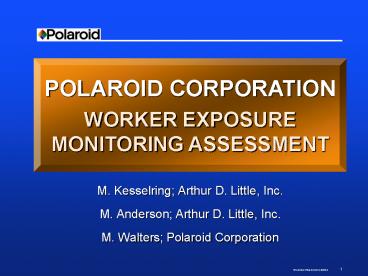M. Kesselring; Arthur D. Little, Inc. - PowerPoint PPT Presentation
1 / 19
Title:
M. Kesselring; Arthur D. Little, Inc.
Description:
POLAROID CORPORATION WORKER EXPOSURE MONITORING ASSESSMENT M. Kesselring; Arthur D. Little, Inc. M. Anderson; Arthur D. Little, Inc. M. Walters; Polaroid Corporation – PowerPoint PPT presentation
Number of Views:140
Avg rating:3.0/5.0
Title: M. Kesselring; Arthur D. Little, Inc.
1
POLAROID CORPORATIONWORKER EXPOSURE MONITORING
ASSESSMENT
- M. Kesselring Arthur D. Little, Inc.
- M. Anderson Arthur D. Little, Inc.
- M. Walters Polaroid Corporation
2
Worker Exposure
3
Project Scope
- Review IH Historical exposure monitoring records
- Review chemical use by process
- Establish a worker exposure matrix inventory by
- Division
- Process Unit Operation
- Exposure Point Chemical Use
- Chemical Agent (MeCl2, isocyanates, etc.)
- Prioritize exposure points for monitoring
- Assess regulatory compliance (CSI 400 and OSHA)
- Design sampling program
4
Scope of Study
- Chemical Operations (3 buildings, 200
processes) - Sheet Coating Operations (3 Buildings, 35
processes) - Negative Coating Operations (2 buildings, 5
processes)
- Battery Manufacturing (1 building, 1 process)
- Reagent Manufacturing Operations (1 building, 30
processes) - Film Assembly Operations (2 buildings)
- Power Boiler Plants
- Other
5
Exposure Assessment Strategy
- Basic characterization
- Exposure assessment
- Prioritize exposures
- Recommendations
6
Basic Characterization
- Review past monitoring data
- Initial tour of facility
- Approach by chemical, process, similar exposure
group - Where/when to focus subsequent visits
- Obtain chemical list, process information,
MSDSs. SOPs, exposure guidelines, workforce
information.
7
Exposure Assessment
- Supervisor/employee interviews
- Subsequent tours
- Engineering controls
- Observe, observe, observe
- Document exposure points
- Estimate exposure ratings
8
Prioritize Exposures
- Assign exposure ratings
- Assign toxicity rating
- Calculate priority rating
- Use ratings and professional judgment to
determine monitoring plan
9
Exposure Rating
Both inhalation and skin exposures are expected
to be negligible lt 10 of the Polaroid Exposure
Guideline (PEG)i.e. closed system with no
potential for release to the work area. Both
inhalation and skin exposures are expected to be
low (11-25 of PEG)i.e. working around closed
systems with potential for release at identified
points. There is a potential for moderate
inhalation and/or skin exposures (25-50 of PEG)
i.e. manual handling of materials with low to
moderate volatility/dustiness There is a
potential for high inhalation and/or skin
exposures (51-99 of PEG) i.e. sampling or
packaging high volatility materials without
sufficient local ventilation Frequent contact
or exposure to the agent at very high
concentrations (gt100 of the PEG)
0 (very low)
1 (low)
2 (moderate)
3 (high)
4 (very high)
10
Toxicity Rating
Description
Toxicity Rating
Very Low (1)
PEG 100 ppm or 10 mg/m3
Low (2)
PEG 50-100 ppm or 5-10 mg/m3
Moderate (3)
PEG 5-50 ppm or 0.5-5 mg/m3
High (4)
PEG 0.5-5 ppm or 0.05-0.5 mg/m3
Very High (5)
PEG lt 0.5 ppm or 0.05 mg/m3
11
PRIORITY RATING
- Toxicity Rating X Exposure Rating
12
Recommendations
- Historical monitoring data
- Priority Rating
- Professional Judgment
- OSHA standards
- Chemicals with very low PEGs
13
Worker Exposure Assessment Plan
- Purpose
- Objective
- Method
- Process Review
- Chemical and Exposure Point Summary
- Review of Historical Monitoring Data
- Recommendations
- Appendices
14
Appendices
- Corporate Safety Instruction
- Department Chemical List (including Process, PEG,
PEL and Toxicity Rating) - Exposure Point Inventory
- Historical IH Monitoring Files
- Chemicals with PEGs less than 0.5 mg/m3
15
Exposure Point List
Exposure Rating
Toxicity Rating
Priority Rating
Exposure Point
Chemical Mix Area
Weighing Zinc Oxide
1 (low)
3 (mod)
3
Charging Mixer with MnO2
2 (mod)
4 (high)
8
16
Duct Cleaning
Exposure Point
Weighing
Raw Materials
Exposure Point
Filter Changes
Exposure Point
17
Recommendations - Worker Exposure Monitoring
- Selection of exposure points for monitoring
- Schedule, priority rationale
- Scope specification of sampling plan
- Monitoring to include
- Ventilation assessment
- Documentation of worker exposures
- Reassessment
18
Recommended Monitoring Plan
Chemical/ Agent
Type of Sample
Min. of Samples
Method
Area/Task
Chemical Mix Area
Weighing Developer Chemicals
Particulates
8-Hour TWA
3
NIOSH 0500
19
Request For Quotation
- Outlines tasks and schedule for completing the
monitoring































